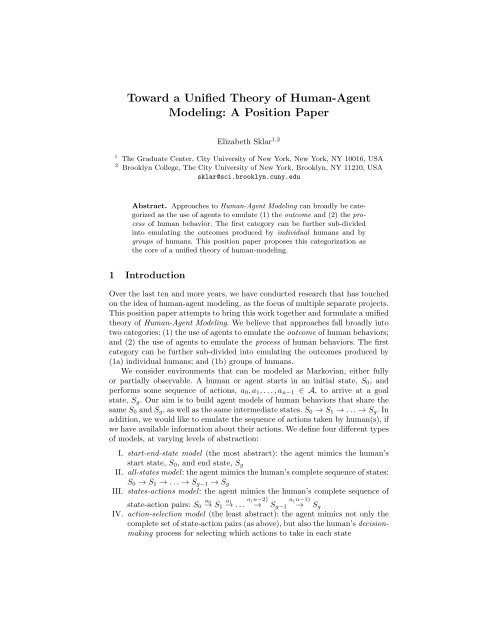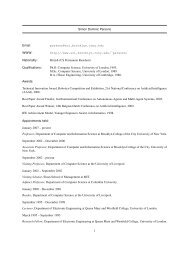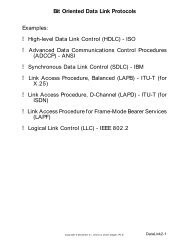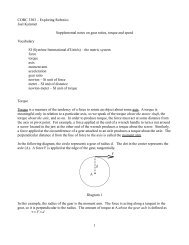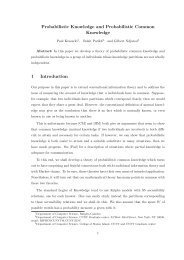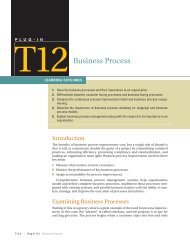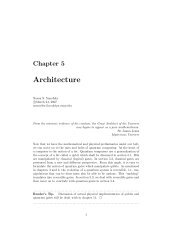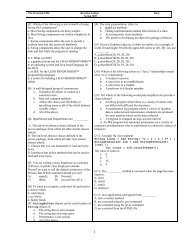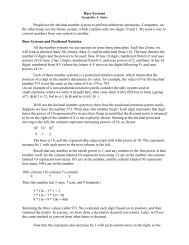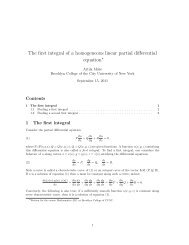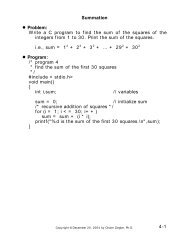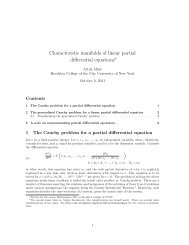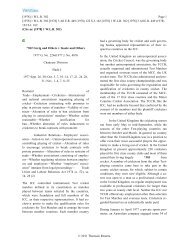Toward a Unified Theory of Human-Agent Modeling: A Position Paper
Toward a Unified Theory of Human-Agent Modeling: A Position Paper
Toward a Unified Theory of Human-Agent Modeling: A Position Paper
Create successful ePaper yourself
Turn your PDF publications into a flip-book with our unique Google optimized e-Paper software.
<strong>Toward</strong> a <strong>Unified</strong> <strong>Theory</strong> <strong>of</strong> <strong>Human</strong>-<strong>Agent</strong><br />
<strong>Modeling</strong>: A <strong>Position</strong> <strong>Paper</strong><br />
Elizabeth Sklar 1,2<br />
1 The Graduate Center, City University <strong>of</strong> New York, New York, NY 10016, USA<br />
2 Brooklyn College, The City University <strong>of</strong> New York, Brooklyn, NY 11210, USA<br />
sklar@sci.brooklyn.cuny.edu<br />
Abstract. Approaches to <strong>Human</strong>-<strong>Agent</strong> <strong>Modeling</strong> can broadly be categorized<br />
as the use <strong>of</strong> agents to emulate (1) the outcome and (2) the process<br />
<strong>of</strong> human behavior. The first category can be further sub-divided<br />
into emulating the outcomes produced by individual humans and by<br />
groups <strong>of</strong> humans. This position paper proposes this categorization as<br />
the core <strong>of</strong> a unified theory <strong>of</strong> human-modeling.<br />
1 Introduction<br />
Over the last ten and more years, we have conducted research that has touched<br />
on the idea <strong>of</strong> human-agent modeling, as the focus <strong>of</strong> multiple separate projects.<br />
This position paper attempts to bring this work together and formulate a unified<br />
theory <strong>of</strong> <strong>Human</strong>-<strong>Agent</strong> <strong>Modeling</strong>. We believe that approaches fall broadly into<br />
two categories: (1) the use <strong>of</strong> agents to emulate the outcome <strong>of</strong> human behaviors;<br />
and (2) the use <strong>of</strong> agents to emulate the process <strong>of</strong> human behaviors. The first<br />
category can be further sub-divided into emulating the outcomes produced by<br />
(1a) individual humans; and (1b) groups <strong>of</strong> humans.<br />
We consider environments that can be modeled as Markovian, either fully<br />
or partially observable. A human or agent starts in an initial state, S0, and<br />
performs some sequence <strong>of</strong> actions, a0, a1, . . . , an−1 ∈ A, to arrive at a goal<br />
state, Sg. Our aim is to build agent models <strong>of</strong> human behaviors that share the<br />
same S0 and Sg, as well as the same intermediate states, S0 → S1 → . . . → Sg. In<br />
addition, we would like to emulate the sequence <strong>of</strong> actions taken by human(s), if<br />
we have available information about their actions. We define four different types<br />
<strong>of</strong> models, at varying levels <strong>of</strong> abstraction:<br />
I. start-end-state model (the most abstract): the agent mimics the human’s<br />
start state, S0, and end state, Sg<br />
II. all-states model: the agent mimics the human’s complete sequence <strong>of</strong> states:<br />
S0 → S1 → . . . → Sg−1 → Sg<br />
III. states-actions model: the agent mimics the human’s complete sequence <strong>of</strong><br />
state-action pairs: S0<br />
a0 a1<br />
→ S1 → . . . a (n−2)<br />
→ Sg−1<br />
a (n−1)<br />
→ Sg<br />
IV. action-selection model (the least abstract): the agent mimics not only the<br />
complete set <strong>of</strong> state-action pairs (as above), but also the human’s decisionmaking<br />
process for selecting which actions to take in each state
Our work has primarily focused on building models <strong>of</strong> type III and IV, which are<br />
the emphasis in this paper, though we have done some work constructing type<br />
II models [1]. We have also found that type II models are useful in evaluating<br />
the results <strong>of</strong> our modeling efforts [2]. (See Section 3.)<br />
The approaches that emulate the outcomes <strong>of</strong> individual humans’ behaviors<br />
(category 1a) produce models <strong>of</strong> type I, II or III. A variety <strong>of</strong> representations<br />
and machine learning techniques can be used to acquire and store such<br />
models. For example, a Bayesian network [3] could represent the probability<br />
that a particular person executes an action in a given state, and a model could<br />
learn the probabilities associated with each state-action pair. (See Section 2.)<br />
The approaches that emulate the outcomes <strong>of</strong> groups <strong>of</strong> humans’ behaviors (1b)<br />
employ a strategy similar to modeling individuals and also produce type I, II or<br />
III models. However, the data used to train the model is based on the collective<br />
behavior <strong>of</strong> multiple individuals. The collective behaviors may be clustered in<br />
various ways, e.g., according to behavior characteristics or demographics. (See<br />
Section 3.) The approaches that emulate the process <strong>of</strong> human behaviors (2)<br />
produce type IV models. These tend to be centered on individuals (though these<br />
approaches could model groups where all members exhibit the same, or similar,<br />
processes), so we do not differentiate between “one” and “many” trainers<br />
in this category. The idea is to model the human’s decision-making process for<br />
action selection—not just what the outcome was, but how she made the choice<br />
<strong>of</strong> action(s) that led to the outcome. (See Section 4.)<br />
Generally speaking, there are two different representation strategies employed<br />
for storing the models produced, each following one <strong>of</strong> the two historically opposing<br />
camps from within the Artificial Intelligence community [4]: symbolic<br />
methods that require manual construction <strong>of</strong> rules which describe behaviors,<br />
versus connectionist methods that require machine learning procedures to evolve<br />
weights or probabilities that guide selection <strong>of</strong> actions based on input states. The<br />
first strategy involves engineering a policy for an agent to follow when selecting<br />
an action given a state, whereas the second involves learning the policy 3 . The<br />
more successful applications <strong>of</strong> the first strategy stem from work done by behavioral<br />
specialists, such as developmental psychologists, in which they observe<br />
human subjects engaging in activities and then create theories about the subjects’<br />
behaviors by analyzing the observations made. Following this procedure,<br />
computational models can then be built that reproduce the subjects’ behaviors.<br />
While the second strategy could also be based on theoretical models from the<br />
literature, the connectionist methods more typically skip that step and learn<br />
directly from quantitative or categorical data that is collected during a period<br />
<strong>of</strong> human subject activity. For example, a human expert could explain to a programmer<br />
how she plays the game <strong>of</strong> Backgammon and the programmer could<br />
engineer a rule set that encodes the expert’s behavior; or a connectionist program<br />
(e.g., neural network) could learn how to play Backgammon by playing<br />
many games against itself [5], another computer player or a human opponent,<br />
and adjusting its weights as it plays.<br />
3 Note that the second also involves engineering the connectionist representation.
(1a) modeling (1b) modeling (2) modeling<br />
representation outcomes <strong>of</strong> outcomes processes<br />
strategy individuals <strong>of</strong> groups<br />
symbolic SimEd, type IV [6] SimEd, type IV [7] MBTI, type IV [8]<br />
connectionist Tron, type III [9] Tron, type III [10]<br />
robotics, type III [11] SimEd, type II & III [2]<br />
Table 1. Categorization <strong>of</strong> approaches to human-agent modeling for projects discussed<br />
in this paper: SimEd (Sections 2 and 3); MBTI (§4); Tron (§2 and §3); robotics (§2).<br />
Our work has primarily focused on using connectionist strategies, though<br />
we have also explored symbolic strategies. Table 1 illustrates how some <strong>of</strong> our<br />
different projects, undertaken since 1997, fit within the categorization described<br />
above. The remainder <strong>of</strong> this paper highlights these examples; and we close with<br />
a brief discussion <strong>of</strong> ongoing and future work.<br />
2 <strong>Modeling</strong> the outcomes <strong>of</strong> individuals’ behaviors<br />
In 1997, we introduced a simple human-vs-agent video game inspired by the<br />
movie Tron and demonstrated one <strong>of</strong> the first Internet-based examples <strong>of</strong> collective<br />
intelligence [12]. In our Tron game, both players move continuously within<br />
a toroidal arena, each leaving an impenetrable trail marking its path (neither<br />
player can cross these trails). The trails do not decay, so eventually the arena fills<br />
up with “walls” and it becomes hard to find safe moves. The agent player has<br />
sensors that measure the distance to the nearest obstacles. Both players have a<br />
choice <strong>of</strong> 3 actions: turn left, turn right, or go straight. The goal is to maximize<br />
the length <strong>of</strong> an episode, by avoiding crashing into walls and staying “alive”<br />
longer than the other player. We trained agents, controlled by genetic programs,<br />
to play Tron by engaging in a co-evolutionary learning process that matched<br />
agents against humans. While this experiment did not model human behaviors<br />
directly, the game logs were mined in subsequent experiments, described next.<br />
Follow-on work [9] introduced the idea <strong>of</strong> using logs <strong>of</strong> humans’ actions, collected<br />
during the game play mentioned above, to train agent-based models <strong>of</strong><br />
the human players. These “trainees” were represented as neural networks with<br />
inputs corresponding to agents’ sensors and outputs corresponding to actions.<br />
The training process reconstructed previously-played games, following the moves<br />
<strong>of</strong> both players recorded in game logs. The human player is designated as the<br />
“trainer”, and the “trainee” network tries to replicate the human’s actions. Before<br />
each action taken by the human trainer, the current state <strong>of</strong> the game arena<br />
is input to the trainee agent’s network, which predicts which action to take.<br />
Then the prediction is compared to the trainer’s action recorded in the log. If<br />
the actions match, then the training sequence proceeds to the next move in the<br />
game. If the actions do not match, then the trainee’s network weights are adjusted<br />
(using back-propagation [13]), in proportion to the prediction error. This<br />
process continues until the trainee can predict its trainer’s actions with accuracy.
We produced 58 different human-trained networks in this manner. For comparison,<br />
we produced a control group <strong>of</strong> networks trained by deterministic agents<br />
(i.e., players that always perform the same action in a given state). To evaluate<br />
the trainees, we ran test games pitting the human-trained networks, their trainers,<br />
the control group and their trainers against a common group <strong>of</strong> deterministicbehavior<br />
opponents (different from the control group). In addition, we also ran<br />
test games pitting the common group against a set <strong>of</strong> random players (i.e., players<br />
that select their actions randomly). We looked for correlation between the<br />
actions selected by trainee-trainer pairs, as well as pairs between the trainees<br />
and the random players. The correlation between trainees and their trainers was<br />
significantly higher than the correlation between trainees and random players,<br />
for both types <strong>of</strong> trainees. The correlation for trainees that trained on deterministic<br />
players was higher than for those that trained on human (non-deterministic)<br />
players. This is not unexpected, since humans naturally produce noisy behaviors.<br />
We did some comparative analysis <strong>of</strong> the variance in the trainees’ behavior<br />
patterns, next to that <strong>of</strong> the human trainers, and we found that the trainees<br />
were able to filter out spurious actions <strong>of</strong> the humans and behave less erratically<br />
while still exhibiting a comparable range <strong>of</strong> normal behaviors.<br />
After the initial Tron work, we subsequently applied this method, training<br />
agents from game logs, to other environments, including educational games [14].<br />
Current work is applying this technique to modeling humans playing more complex<br />
games (Tetris [15] and Poker [16]) and to modeling behaviors <strong>of</strong> humans<br />
performing a task in which they assign keywords to natural language data sets<br />
that discuss medical conditions. In addition, we are applying this approach using<br />
a learning from demonstration algorithm [17] in a robotics domain, facilitating<br />
a human teacher to train a robot to avoid obstacles [11].<br />
The SimEd classroom project [6] involves emulating the outcomes <strong>of</strong> humans<br />
in a simulated learning environment in which different types <strong>of</strong> behaviors are<br />
exhibited by agent-based models <strong>of</strong> students and teachers. The knowledge being<br />
acquired by these simulated students is an abstract set <strong>of</strong> concepts, represented<br />
symbolically: {c0, c1, . . . cn−1} ∈ C. A state in this environment is defined by<br />
the subset <strong>of</strong> concepts (⊆ C) that the simulated teacher has presented and the<br />
simulated student has acquired. (The teacher agents are assumed to “know” all<br />
the concepts in C.) The teacher performs two tasks: act, by selecting a concept<br />
ci ∈ C to present to the student, with the ultimate goal <strong>of</strong> helping the student<br />
acquire all elements in C; and react, by evaluating the student’s response to ci.<br />
There are n = |C| choices <strong>of</strong> action and 2 choices <strong>of</strong> reaction (“right” or “wrong”).<br />
In between, the student acts by selecting a response to ci which results in either<br />
acquiring ci or not, or acquiring some portion <strong>of</strong> ci. The student’s action choices<br />
are abstracted into degrees <strong>of</strong> correct knowledge about the current ci, depending<br />
on the value <strong>of</strong> a learning rate parameter.<br />
We applied a symbolic approach to modeling the behavior <strong>of</strong> individual humans<br />
in the SimEd classroom project [6]. <strong>Agent</strong> models <strong>of</strong> students and teachers<br />
were derived from theories <strong>of</strong> teaching and learning described in pedagogical literature<br />
(e.g., [18–20]). Three different teacher behavior models were compared.
In the lecture model, the teacher agent selects new ci’s regardless <strong>of</strong> students’<br />
progress. In the lecture-feedback model, the teacher selects new ci’s when the<br />
majority <strong>of</strong> students had acquired previously-presented cj’s (i �= j). In the tutorial<br />
model, the teacher selects customized ci’s for students, based on individual<br />
progress with previously-presented cj’s. The student model was derived from<br />
the trilogy <strong>of</strong> mind theory <strong>of</strong> knowledge acquisition [18], where the probability<br />
<strong>of</strong> action selection is computed according to the student’s current set <strong>of</strong> beliefs<br />
(cognition) and attitude (emotion and motivation). The simulation results were<br />
not surprising: the tutorial model produced the best learning outcomes, in terms<br />
<strong>of</strong> acquisition <strong>of</strong> more concepts by more students; and students with higher cognitive<br />
ability and stronger motivation to learn acquired more concepts.<br />
3 <strong>Modeling</strong> the outcomes <strong>of</strong> group behaviors<br />
One <strong>of</strong> our primary motivations for investigating human behavior modeling is<br />
not to mimic individuals, but rather to emulate groups <strong>of</strong> humans. We analyzed<br />
data collected in the first 15 months <strong>of</strong> the Tron experiment, examined the<br />
“win rates” <strong>of</strong> the human players (i.e., the number <strong>of</strong> games won divided by<br />
the number <strong>of</strong> games played) and categorized them into clusters based on win<br />
rate (e.g., humans who win 10% <strong>of</strong> their games, 50%, 90%, etc.). We found that<br />
the distribution <strong>of</strong> clusters remained relatively constant over time, despite the<br />
steady increase in the number <strong>of</strong> different people playing games on the site; i.e.,<br />
although the number <strong>of</strong> players increased, the proportions <strong>of</strong> “terrible” (10% win<br />
rate), “fair” (50% win rate) and “expert” (90+% win rate) players remained the<br />
same. We wanted to see if we could train agents to imitate each group—could we<br />
create a terrible, a fair and an expert agent player? If we could, then we would<br />
have a suite <strong>of</strong> players who could be matched against humans who were learning<br />
to play and provide a scaffolded series <strong>of</strong> opponents to aid human learners.<br />
We repeated the process used for training on individuals’ data, but instead<br />
<strong>of</strong> using data from one human, we clustered human players based on their win<br />
rates and used the combined game logs from all the humans in the same cluster<br />
as input [10]. These training data sets were naturally larger than those used for<br />
training on individuals’ data, and the results were better. Despite the fact that<br />
the training data was a merged set <strong>of</strong> actions from multiple people’s games, the<br />
result was a suite <strong>of</strong> agents that could reliably play at the levels matching their<br />
trainers. We repeated this process within the educational games environment<br />
mentioned above [10, 14]. The results surpassed those from Tron because the<br />
educational games were in static environments and the state space was smaller.<br />
Subsequently, also part <strong>of</strong> the SimEd project, we applied the technique to<br />
modeling children’s behaviors in an interactive educational assessment environment<br />
[2] and experimented with different ways <strong>of</strong> grouping the human trainers.<br />
The domain, an educational assessment instrument, consisted <strong>of</strong> a sequence <strong>of</strong><br />
questions and was administered to elementary school children in order to screen<br />
for learning disabilities. The assessment was adaptive: after an initial fixed sequence,<br />
questions were chosen dynamically, based on students’ answers. In the
data we studied, students responded to a subset <strong>of</strong> 7-8 questions, out <strong>of</strong> 94. A<br />
student’s pattern <strong>of</strong> right and wrong answers governed her “trajectory” through<br />
the assessment landscape (i.e., the subset and sequence <strong>of</strong> questions answered).<br />
We built agent-based models <strong>of</strong> students from logs that recorded 117 students’<br />
answers to questions in the assessment, and experimented with two different<br />
measures for clustering the training sets. One method was to create a 94element<br />
feature vector in which each question was encoded as “right”, “wrong” or<br />
“not seen” and classify students based on the Euclidean distance between feature<br />
vectors. The second method was to measure the distance between trajectories in<br />
the landscape using the Hausdorff geometric distance measure [21]. We applied<br />
a hierarchical clustering technique to both measures, generating two different<br />
partitions <strong>of</strong> student transaction logs. Then we trained agents to emulate the<br />
outcomes <strong>of</strong> the students in each group. The agents were represented using probabilistic<br />
influence networks [3], and were evaluated by deploying in a simulated<br />
version <strong>of</strong> the educational assessment and logging answers. We compared the<br />
correlation between trainee-trainer pairs resulting from each clustering measure,<br />
indicating how closely the trainees replicated the question-answering behavior <strong>of</strong><br />
their trainers. Our results showed that the trajectory-based clustering produced<br />
superior correlation to the feature-based clustering. We believe this is because<br />
the trajectory method takes into account the sequence and dependencies between<br />
questions, whereas the feature method views questions independently.<br />
In follow-on work to the SimEd classroom project, we simulated learning in<br />
groups <strong>of</strong> human students [7]. Based on multiple pedagogical theories <strong>of</strong> group<br />
learning, we engineered a model in which simulated students are presented with<br />
concepts (as in [6]) and interact in groups in order to acquire the concepts.<br />
We experimented with different compositions <strong>of</strong> “low” and “high” ability learners<br />
in groups and different reward structures (“individual”, “competitive” and<br />
“cooperative”), to determine the combination that produced the best results in<br />
terms <strong>of</strong> acquisition <strong>of</strong> more concepts by more students. The competitive and<br />
cooperative reward structures assigned the same reward to all members <strong>of</strong> the<br />
group based on how the group performed in relation to other groups. The results<br />
demonstrated that cooperative reward structures help low ability learners<br />
progress as part <strong>of</strong> a heterogeneous group more rapidly than other reward structures<br />
or homogeneous group assignments. This mirrors reports in pedagogical<br />
literature that describe observations <strong>of</strong> human classrooms.<br />
4 <strong>Modeling</strong> the process <strong>of</strong> individuals’ behaviors<br />
Although we have primarily focused on constructing models that emulate the<br />
outcomes <strong>of</strong> human behaviors, some <strong>of</strong> our more recent work has involved emulating<br />
the process <strong>of</strong> humans selecting actions (i.e., model type IV). In our MBTI<br />
project [8, 22], we apply the Myers-Briggs Type Indicator theory <strong>of</strong> human personality<br />
[23] to agents acting in a simple artificial life environment [24]. This theory<br />
defines human personalities along 4 axes: extroversion versus introversion;<br />
sensing versus intuition; thinking versus feeling; and judging versus perceiving.
Each <strong>of</strong> these dichotomies influence how humans interpret input, interact with<br />
others and make decisions. By recognizing a tendency for one extreme within<br />
each dichotomy, the MBTI theory classifies people into sixteen different “personality<br />
types”. In our simulated environment, we created agents <strong>of</strong> each type, who<br />
make different action-selection decisions according to their personality type. Our<br />
results demonstrate different outcomes that reflect those personality types. For<br />
example, agents with introverted personality types, who lose energy when interacting<br />
with others, are less efficient in completing tasks in densely populated<br />
environments as compared to sparsely populated environments.<br />
5 Summary<br />
This position paper has proposed a unified theory <strong>of</strong> human-agent modeling that<br />
defines two major categories <strong>of</strong> approaches: emulating the outcome <strong>of</strong> human behaviors<br />
and emulating the process <strong>of</strong> human behaviors. The outcome-based approaches<br />
can be further sub-divided into models based on individuals or groups<br />
<strong>of</strong> humans. Four types <strong>of</strong> models have been described, ranging in levels <strong>of</strong> abstraction<br />
from the most coarse, where only start and end states are modeled, to<br />
most specific, where the process <strong>of</strong> action-selection is mimicked. Two techniques<br />
for model representation were discussed: symbolic and connectionist. Examples<br />
<strong>of</strong> each were highlighted from previous and ongoing projects.<br />
A number <strong>of</strong> key lessons have been learned. First, training agents on human<br />
transaction logs results in controllers that filter out anomalous actions and<br />
produce more consistent patterns <strong>of</strong> behavior, i.e., with less variance in action<br />
selection than human trainers. Second, constructing computational models from<br />
theories suggested in literature requires careful validation efforts, which are not<br />
necessarily easy to design and may be controversial. Finally, creating graphical<br />
representations <strong>of</strong> state and action landscapes opens the door to a wide range<br />
<strong>of</strong> methodologies that can be used to compare and assess behavior models.<br />
Current efforts involve deeper exploration <strong>of</strong> this unified theory by reviewing<br />
a wide range <strong>of</strong> behavior modeling projects and assessing the broader applicability<br />
<strong>of</strong> our categorization. As well, application <strong>of</strong> the theory to more complex<br />
domains—some mentioned here—is underway. This includes investigation <strong>of</strong> a<br />
mixed-model-type approach where models <strong>of</strong> types III and IV are combined by<br />
overlaying personality type on agents in the SimEd and gaming environments.<br />
Acknowledgments<br />
I am grateful for the invaluable input <strong>of</strong> the many graduate students who have<br />
worked with me on the projects described in this paper (Kenneth Auyeung,<br />
Mathew Davies, Ilknur Icke, J. Pablo Munoz, Jeffery Raphael, Jordan Salvit,<br />
and Maartje Spoelstra), as well as my collaborators on the original Tron project<br />
(Pablo Funes, Hugues Juillé, Jordan Pollack and Alan Blair). This work has<br />
been supported by a number <strong>of</strong> grants from the National Science Foundation<br />
(ITR-0113317, ITR-0219347, ITR-0552294, IIP-0637713, IIS-1117000).
References<br />
1. Tang, Y., Parsons, S., Sklar, E.: An agent-based model that relates investment in<br />
education to economic prosperity. In: Autonomous <strong>Agent</strong>s and Multiagent Systems<br />
(AAMAS). (2007)<br />
2. Sklar, E., Icke, I.: Using simulation to evaluate data-driven agents. Multi-agent<br />
Based Simulation (MABS) LNAI 5269 (2009)<br />
3. Pearl, J.: Probabilistic reasoning in intelligent systems: networks <strong>of</strong> plausible inference.<br />
Morgan Kaufmann (1988)<br />
4. Russell, S., Norvig, P.: Artificial Intelligence. Prentice Hall (2003)<br />
5. Pollack, J.B., Blair, A.D.: Co-evolution in the successful learning <strong>of</strong> backgammon<br />
strategy. Machine Learning 32 (1998)<br />
6. Sklar, E., Davies, M.: Multiagent simulation <strong>of</strong> learning environments. In: Autonomous<br />
<strong>Agent</strong>s and Multi <strong>Agent</strong> Systems (AAMAS). (2005)<br />
7. Spoelstra, M., Sklar, E.: Using simulation to model and understand group learning.<br />
<strong>Agent</strong> Based Systems for <strong>Human</strong> Learning, International Transactions on Systems<br />
Science and Applications 4(1) (2008)<br />
8. Salvit, J., Sklar, E.: <strong>Toward</strong> a myers-briggs type indicator model <strong>of</strong> agent behavior.<br />
Multi-<strong>Agent</strong>-Based Simulation (MABS) LNAI 6532 (2010)<br />
9. Sklar, E., Blair, A.D., Funes, P., Pollack, J.: Training Intelligent <strong>Agent</strong>s Using<br />
<strong>Human</strong> Internet Data. In: Intelligent <strong>Agent</strong> Technology (IAT). (1999)<br />
10. Sklar, E., Blair, A.D., Pollack, J.B.: Ch 8: Training Intelligent <strong>Agent</strong>s Using <strong>Human</strong><br />
Data Collected on the Internet. In: <strong>Agent</strong> Engineering. World Scientific (2001)<br />
11. Munoz, J.P., Ozgelen, A.T., Sklar, E.: Learning from Demonstration in Spatial<br />
Exploration. In: AAAI Robotics Workshop and Exhibition. (2011)<br />
12. Funes, P., Sklar, E., Juillé, H., Pollack, J.B.: Animal-Animat Coevolution: Using<br />
the Animal Population as Fitness Function. In: Simulation <strong>of</strong> Adaptive Behavior<br />
(SAB), MIT Press (1998)<br />
13. Rumelhart, D.E., Hinton, G.E., Williams, R.J.: Learning representations by backpropagating<br />
errors. Nature 323 (1986)<br />
14. Sklar, E.: CEL: A Framework for Enabling an Internet Learning Community. PhD<br />
thesis, CS Dept, Brandeis Univ, Advisor: J. Pollack (2000)<br />
15. Raphael, J.: Masters thesis proposal: Social learning as a method <strong>of</strong> knowledge<br />
transfer for a tetris agent. CIS Dept, Brooklyn College, CUNY, Advisor: E. Sklar<br />
(Jan 2012)<br />
16. Auyeung, K.Y.: Masters thesis proposal: A neural network approach to developing<br />
robust poker strategies. CIS Dept, Brooklyn College, CUNY, Advisor: E. Sklar<br />
(Jan 2012)<br />
17. Chernova, S., Veloso, M.: Interactive policy learning through confidence-based<br />
autonomy. JAIR 34(1) (2009)<br />
18. Lazarus, R.S.: Cognition and Motivation in Emotion. American Psychologist 46(4)<br />
(1991)<br />
19. Gardner, H.: Frames <strong>of</strong> Mind. BasicBooks (1983)<br />
20. <strong>Paper</strong>t, S., Harel, I.: Constructionism. Ablex (1991)<br />
21. Rote, G.: Computing the minimum hausdorff distance between two point sets on<br />
a line under translation. Information Processing Letters 38 (1991)<br />
22. Salvit, J.: A Myers-Briggs Type Indicator Model <strong>of</strong> <strong>Agent</strong> Behavior. Master’s<br />
thesis, CIS Dept, Brooklyn College, CUNY, Advisor: E. Sklar (2012)<br />
23. Myers, I.B., Myers, P.B.: Gifts Differing. Consulting Psychologists Press (1980)<br />
24. Resnick, M.: Turtles, Termites, and Traffic Jams: Explorations in Massively Parallel<br />
Microworlds. MIT Press (1997)


